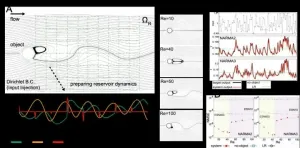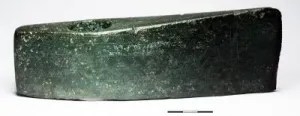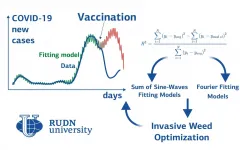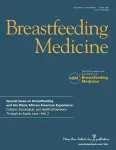Passing the COVID test in just five minutes
Researchers at Osaka University develop a new highly sensitive test for the SARS-CoV-2 virus that utilizes a fusion of artificial intelligence and nanopore technology which may enable rapid point-of-care testing for COVID
2021-06-17
(Press-News.org) Osaka, Japan - A team of scientists headed by SANKEN (The Institute of Scientific and Industrial Research) at Osaka University demonstrated that single virus particles passing through a nanopore could be accurately identified using machine learning. The test platform they created was so sensitive that the coronaviruses responsible for the common cold, SARS, MERS, and COVID could be distinguished from each other. This work may lead to rapid, portable, and accurate screening tests for COVID and other viral diseases.
The global coronavirus pandemic has revealed the crucial need for rapid pathogen screening. However, the current gold-standard for detecting RNA viruses--including SARS-CoV-2, the virus that causes COVID--is reverse transcription-polymerase chain reaction (RT-PCR) testing. While accurate, this method is relatively slow, which hinders the timely interventions required to control an outbreak.
Now, scientists led by Osaka University have developed an intelligent nanopore system that can be used for the detection of SARS-CoV-2 virus particles. Using machine-learning methods, the platform can accurately discriminate between similarly sized coronaviruses responsible for different respiratory diseases. "Our innovative technology has high sensitivity and can even electrically identify single virus particles," first author Professor Masateru Taniguchi says. Using this platform, the researchers were able to achieve a sensitivity of 90% and a specificity of 96% for SARS-CoV-2 detection in just five minutes using clinical saliva samples.
To fabricate the device, nanopores just 300 nanometers in diameter were bored into a silicon nitride membrane. When a virus was pulled through a nanopore by the electrophoretic force, the opening became partially blocked. This temporarily decreased the ionic flow inside the nanopore, which was detected as a change in the electrical current. The current as a function of time provided information on the volume, structure, and surface charge of the target being analyzed. However, to interpret the subtle signals, which could be as small as a few nanoamps, machine learning was needed. The team used 40 PCR-positive and 40 PCR-negative saliva samples to train the algorithm.
"We expect that this research will enable rapid point-of-care and screening tests for SARS-CoV-2 without the need for RNA extraction," Professor Masateru Taniguchi explains. "A user-friendly and non-invasive method such as this is more amenable to immediate diagnosis in hospitals and screening in places where large crowds are gathered." The complete test platform consists of machine learning software on a server, a portable high-precision current measuring instrument, and cost-effective semiconducting nanopore modules. By using a machine-learning method, the researchers expect that this system can be adapted for use in the detection of emerging infectious diseases in the future. The team hopes that this approach will revolutionize public health and disease control.
INFORMATION:
The article, "Combining machine learning and nanopore construction creates an artificial intelligence nanopore for coronavirus detection" was published in Nature Communications at DOI: https://doi.org/10.1038/s41467-021-24001-2
About Osaka University
Osaka University was founded in 1931 as one of the seven imperial universities of Japan and is now one of Japan's leading comprehensive universities with a broad disciplinary spectrum. This strength is coupled with a singular drive for innovation that extends throughout the scientific process, from fundamental research to the creation of applied technology with positive economic impacts. Its commitment to innovation has been recognized in Japan and around the world, being named Japan's most innovative university in 2015 (Reuters 2015 Top 100) and one of the most innovative institutions in the world in 2017 (Innovative Universities and the Nature Index Innovation 2017). Now, Osaka University is leveraging its role as a Designated National University Corporation selected by the Ministry of Education, Culture, Sports, Science and Technology to contribute to innovation for human welfare, sustainable development of society, and social transformation.
Website: https://resou.osaka-u.ac.jp/en
[Attachments] See images for this press release:
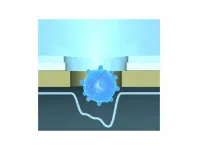
ELSE PRESS RELEASES FROM THIS DATE:
2021-06-17
[Background]
In recent years, physical reservoir computing*1), one of the new information processing technologies, has attracted much attention. This is a physical implementation version of reservoir computing, which is a learning method derived from recurrent neural network (RNN)*2) theory. It implements computation by regarding the physical system as a huge RNN, outsourcing the main operations to the dynamics of the physical system that forms the physical reservoir. It has the advantage of obtaining optimization instantaneously with limited computational resources by adjusting linear and static readout weightings between the output and a physical reservoir without requiring optimization of the weightings by back propagation. However, since the information processing capability depends ...
2021-06-17
SINGAPORE, 17 June 2021 - New details on the structure and function of a transport protein could help researchers develop drugs for neurological diseases that are better able to cross the blood-brain barrier. The findings were published in the journal Nature by researchers at Columbia University Vagelos College of Physicians and Surgeons, Duke-NUS Medical School, Weill Cornell Medicine and colleagues.
Omega-3 fatty acids, like docosahexaenoic acid (DHA), are important for brain and eye development. They are derived mainly from dietary sources and converted ...
2021-06-17
New research presents over 300 new analyses of bronze objects, raising the total number to 550 in 'the archaeological fingerprint project'. This is roughly two thirds of the entire metal inventory of the early Bronze Age in southern Scandinavia. For the first time, it was possible to map the trade networks for metals and to identify changes in the supply routes, coinciding with other socio-economic changes detectable in the rich metal-dependent societies of Bronze Age southern Scandinavia.
The magnificent Bronze Age in southern Scandinavia rose from copper traded from the British Isles and Slovakia 4000 years ago. 500 ...
2021-06-17
In a paper published in NANO, a team of researchers from Jiangnan University, China have prepared a convenient sensing platform which can detect microRNA-205 (MiR-205) with high sensitivity and excellent selectivity using TpTta-COF nanosheet and fluorescent oligonucleotide probes.
Nasopharyngeal carcinoma (NPC) is a kind of malignant cancer derived from the epithelial cells, which shows an apparent regional aggregation with a high prevalence in Southern China and Southeast Asia. With the ongoing improvement of radiotherapy technology, the therapeutic effect of NPC patients has been increased significantly. However, the easy recurrence and metastasis still cause the poor prognosis of NPC patients. Many researches indicated that ...
2021-06-17
RUDN University mathematicians built a model of COVID-19 spreading based on two regression models. The mathematicians divided the countries into three groups, depending on the spreading rate and on the climatic conditions, and found a suitable mathematical approximation for each of them. Based on the model, the mathematicians predicted the subsequent waves. The forecast was accurate in countries where mass vaccination was not introduced. The results are published in Mathematics.
The epidemy spreading rate within the country depends, among other things, on the climatic ...
2021-06-17
In recent years, significant progress has been made towards the use of high-resolution peripheral computed tomography (HR-pQCT) imaging in research, and new potential for applications in the clinic have emerged, particularly with the advent of second generation devices.
A newly published state-of-the-art publication on the use and future directions of HR-PQCT provides a concise overview of current clinical applications as well as valuable guidance on the interpretation of results.
Specifically, it gives an overview of:
differences and reference data for HR-pQCT variables by age, sex, body composition and race/ethnicity;
fracture risk prediction using HR-pQCT, specifically in regard to bone microarchitecture in individuals ...
2021-06-17
AURORA, COLORADO, June 16, 2021 -- Foresight Diagnostics, the emerging leader in blood-based lymphoma disease monitoring, announced today that clinical performance of its minimal residual disease (MRD) detection platform in diffuse large B-cell lymphoma (DLBCL) will be presented at the 16th International Conference on Malignant Lymphoma (ICML) on June 18-22, 2021. The oral presentation demonstrates the utility of Foresight Diagnostics' proprietary PhasED-Seq technology to improve MRD detection rates in DLBCL patients in low-disease burden settings.
"Foresight's MRD testing platform can detect relapsing disease 200 ...
2021-06-17
Cancer cells can develop resistance to therapy through both genetic and non-genetic mechanisms. But it is unclear how and why one of these routes to resistance prevails. Understanding this 'choice' by the cancer cells may help us devise better therapeutic strategies. Now, the team of Prof. Jean-Christophe Marine (VIB-KU Leuven Center for Cancer Biology) shows that the presence of certain stem cells correlates with the development of nongenetic resistance mechanisms. Their study is published in the prestigious journal Cancer Cell.
Two routes to resistance
Even though cancer therapy has made great strides in the ...
2021-06-17
African American mothers continue to have the lowest breastfeeding rates, even as the breastfeeding rates have risen in the U.S. over the past 25 years. Racism is an important barrier to breastfeeding, as examined in Part 2 of a special issue on "Breastfeeding and the Black/African American Experience: Cultural, Sociological, and Health Dimensions Through an Equity Lens," published in the peer-reviewed journal Breastfeeding Medicine. Click here to read the issue now.
The special issue is led by Guest Editor Sahira Long, MD, a pediatrician and lactation consultant.
Exploring how racism creates barriers to breastfeeding for Black mothers and how Black women resist racism during their quest to breastfeed are Catasha Davis, PhD and Aubrey Van Kirk Villalobos, DrPH, Milken Institute School ...
2021-06-17
Since 2005, the guidelines for the care of unconscious cardiac arrest patients have been to cool the body temperature down to 33 degrees Celsius. A large, randomised clinical trial led by Lund University and Region Skåne in Sweden has shown that this treatment does not improve survival. The study is published in the New England Journal of Medicine.
"These results will affect the current guidelines", says Niklas Nielsen, researcher at Lund University and consultant in anaesthesiology and intensive care at Helsingborg Hospital, who led the study.
In the early 2000s, two studies in the New England Journal of Medicine showed that induced hypothermia in unconscious cardiac arrest patients ...
LAST 30 PRESS RELEASES:
[Press-News.org] Passing the COVID test in just five minutes
Researchers at Osaka University develop a new highly sensitive test for the SARS-CoV-2 virus that utilizes a fusion of artificial intelligence and nanopore technology which may enable rapid point-of-care testing for COVID

